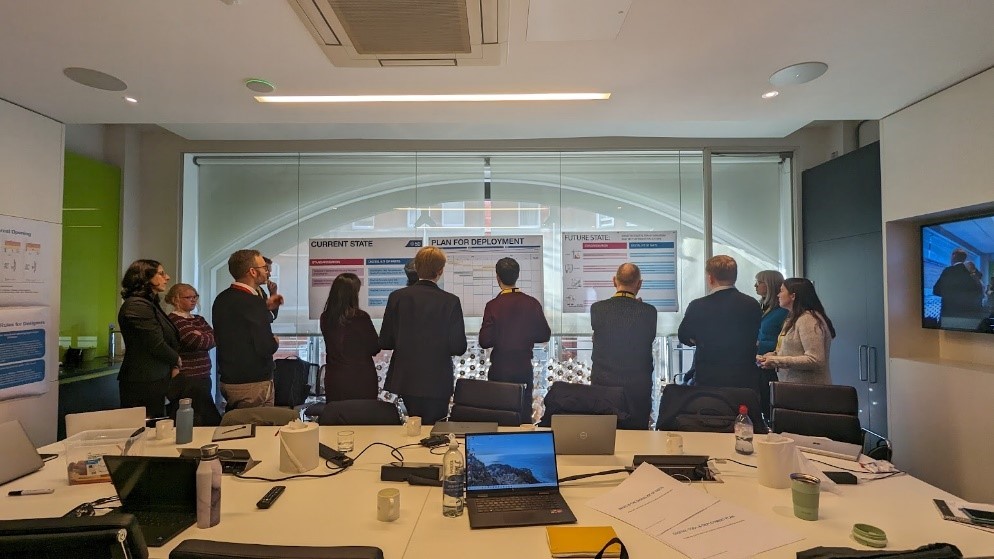Collaboration Projects: Ensuring Success
Author: Hannah Limberger - Project Manager
MODERN METHODS OF CONSTRUCTION RESEARCH STANDARDISATION AND KIT OF PARTS PROJECT
Project partners: Akerlof, HLM Architects, Buro Happold and Limberger associates.
Funded through Department for levelling up housing and communities (DLUHC)
the d-KoP has evolved into a genuinely innovative end product, for the first time connecting both ends of the construction process; a sentiment echoed by our industry stakeholders."
At Limberger Associates, one of our key attributes is our adaptability. As project management professionals, we thrive in dynamic environments, where each project presents fresh and exciting opportunities.
Navigating our role as project managers also presents unique challenges: whether we’re involved from the project’s inception or brought in part way through. At the outset, we are often introduced to new teams, often working remotely, and sometimes in different countries. Conversely, being pulled into a project midstream brings its own set of hurdles: arriving after multiple fires have already started means we need to be swift to adapt and respond, bringing structure across multidisciplinary environments and managing the firefighting that inevitably ensues.
Whatever the scenario, our task is to ensure we implement the appropriate measures to ensure success of the project and in doing so, instil confidence in our clients and fellow partners that a successful trajectory can be maintained.
The DLUHC MMC Kit of Parts project
Our experience to date has largely been in collaboration projects, and it’s within this environment of challenge, innovation, diversity and sometimes, ambiguity, where we excel. So it seemed fitting when we were approached to become a partner for the Department of Levelling Up, Housing and Communities’ (DLUHC) ‘Modern Methods of Construction (MMC) Standardisation Research and Kit of Parts’ project.
Hugely dependent on collaboration, the project’s key objective is to create a digital kit of parts (d-KoP) for Cat 2 & 5 MMC components . Joining us on the journey were our fellow project partners: Akerlof who led extensive industry engagement, HLM Architects led on research, and Buro Happold provided their critical technical expertise; all working together to bring the d-KoP to life.
As Project Manager, it’s never my role to be the expert. However my role is to coordinate the expertise provided and ensure the project is delivering to requirements, expectations, and scope. In this particular project, my role encompassed schedule development and maintenance, risk facilitation and reporting. Reporting involved monthly reviews with our client, DLUHC, and fortnightly discussions with the DLUHC point of contact. Due to the amount of work undertaken in this year-long project, we often had tight deadlines and time moved very quickly. This therefore required lots of discussions with the workstream leads to ensure they were on track and that priorities were clear. Hence, communication took up the majority of my time, which is fairly typical.
As an agile research project, it was crucial to adapt to changes in approach and schedule as research developed, to ensure clarity of the requirements that needed to be met but allowing the methodology and the process to evolve.
The outcome of this is that throughout the past year the d-KoP has evolved into a genuinely innovative end product, for the first time connecting both ends of the construction process; a sentiment echoed by our industry stakeholders.
A Bit of context
This project officially kicked off in January 2023, marking the beginning of an exciting journey that came to a close at the start of April 2024. It was launched in response to the Department’s own stakeholder engagement, which highlighted the need for greater standardisation in the sector. It builds upon the good work demonstrated in previous projects, such as AIMCH and CIH (both funded through the Transforming Construction programme), to meet the aim of building of more homes that are better quality, safer, greener and more affordable.
This aim is supported by numerous studies and reports, which have similarly concluded that the construction sector suffers from poor productivity, fragmentation and lack of collaboration [1]. Of course, there are many examples of great collaboration, excellent innovations and improving productivity, but the sector is also seeing many high-profile business failures that highlight some of the challenges we’re facing.
Working together towards a common goal
Collaboration is a crucially important skill for project managers to master, particularly in the construction industry, where the task of aligning diverse stakeholders—architects, engineers, consultants, and contractors—becomes paramount amidst the industry’s ongoing adaptations. A big part of a project manager’s role is about bringing these parties together to innovate and propel progress, despite the challenges.
As a Project Manager, I’ve seen firsthand how a clear approach and the relationships I build with my team are key to ensuring great collaboration. It’s about creating a space where everyone feels valued and heard, where ideas can flow freely, and where we can work together towards a common goal. In the case of the DLUHC MMC d-KoP project, we began with willing participants, which is a great start and makes our job a little easier!

Three principles for success
To give you some insight into our approach within the DLUHC MMC Standardisation Research and Kit of Parts project, we’ve picked out three key areas to illustrate what we think great collaboration looks like.
1. Encouraging diversity
In any successful project, diversity of thought is essential. Whilst we as Project Managers may not necessarily be the subject matter experts in our project environments, our team, partners, and stakeholders bring invaluable expertise to the table. In the case of our DLUHC project partners, Akerlof, HLM & Buro all contributed their specialised knowledge, working collectively, with oversight from the Strategic Advisory Board, brilliantly led by Trina Chakravati of Building Better.
As part of our project management role, we ensure that meetings are structured to harness the expertise of those around us, encouraging and creating an environment that facilitates and encourages diversity of opinions and views. This sometimes means we facilitate discussion, rather than assuming we lead it, just piping up to encourage someone else’s input or asking questions that may seem simple but often lead to valuable insights. Through collaboration and open dialogue, we ensure alignment on the path forward and next steps.

2. Leadership
Effective collaboration hinges on good leadership. From my perspective, our role can and should be a lot more than simply managing data: it’s about nurturing relationships and guiding people. Going beyond the traditional role of a project manager, my leadership approach is therefore strongly influenced by my ethics, morals, and values.
I stay close to studies and works by APM and other similar organisations, which share how important good leadership is to encourage collaborative environments. As a business, we believe it’s important to add the personal approach to our projects, ensuring that, even remotely, we are fostering communication, empathy and agility, which are all key components of good leadership.
In this project, this was a lot about encouraging the inputs of others for project reviews, allowing them to share the great strides they had accomplished and have ownership over this. This project, due to its agile nature, was less focused on the more technical skills of project management such as cost benefit analysis and schedule KPI’s, and more on managing a team, managing communications with key stakeholders and ensuring requirements and payment milestones were met.
To establish understanding of the requirements we ran a requirements workshop in person at the very start of this project. This provided a great opportunity to get the whole team together in person, to build relationships, whilst working through the project requirements and understand how these would translate into deliverables.
Our aim is to cultivate environments that inspire confidence and positivity among our teams, driving impactful outcomes and fostering growth.
3. Ethics
Ethical standards, now more than ever, form the cornerstone of professionalism, essential not only in business but also in our personal lives.
Project managers are entrusted not merely with the execution of tasks, but with the stewardship of integrity throughout the project lifecycle. This entails upholding principles of honesty, fairness, and transparency in all interactions and decisions, regardless of the pressures or complexities inherent in the project environment.
As a practical example, transparency in decision-making is really important for conflict resolution and informed choice. By listening to and valuing everyone’s contributions, project managers can steer the project onto its most optimal trajectory.
This is what makes collaborative partnerships so exciting: when values and ethics are embraced by larger organisations or integrated teams, their impact is magnified. Key to this is forming relationships where team members feel comfortable to share concerns that I can then decide whether to escalate to the Governance Board for discussion and resolution.
I ensured a consistent and equitable approach across all partners and, with such strong commitment to this project, and importantly the ownership over this work from all partners, this allowed for trust and commitment to be developed so that important activities would be completed.
Our collaborative efforts with the DLUHC project team have ultimately led to the development of an approach that fosters a more open, collaborative, and interoperable MMC solution.
What’s next for the project?
We have completed the final stages of this project with successful outcomes and we eagerly anticipate sharing our progress with you. Through the outstanding collaboration of Akerlof, HLM Architects, and Buro Happold, we’ve made remarkable strides that we’re excited to showcase.
By facilitating increased collaboration across the supply chain, from planning and design to procurement and manufacture, our aim has been to develop a tool that will improve productivity and reduce fragmentation. The project’s outcomes promise to bring substantial value to the process of home design and procurement, accessible to all without barriers.
In essence, this project has been more than just a professional endeavour: at Limberger Associates, collaborative environments are our niche, but the results have been a testament to the wider teamwork and innovation and, as we near the finish line, I couldn’t be prouder of what we’ve accomplished together. Make sure you check out blogs by HLM Architects and Akerlof that share great insights on this project.
The Kit is Greater than the Sum of its Parts. – HLM Architects
[1] Defined by MMC Framework: Modern Methods of Construction working group: developing a definition framework – GOV.UK (www.gov.uk)
[2] The Farmer Review of 2016, the RICS Construction productivity reports, and several reports by McKinsey to name a few, some refreshed yearly, with similar messages
About our business
At Limberger Associates, we bring our suite of proven project management tools, processes and templates, alongside our extensive industry experience, to every project. However, how we apply these tools, and how we approach our relationships continually evolves, shifts and adapts on a project-by-project basis, sometimes during a project.
As a small family-led business, this adaptability is integral to our success. Recognising that each project is unique, we tailor our approach accordingly, enabling us to provide a personalised, ethically focused service to our clients.


